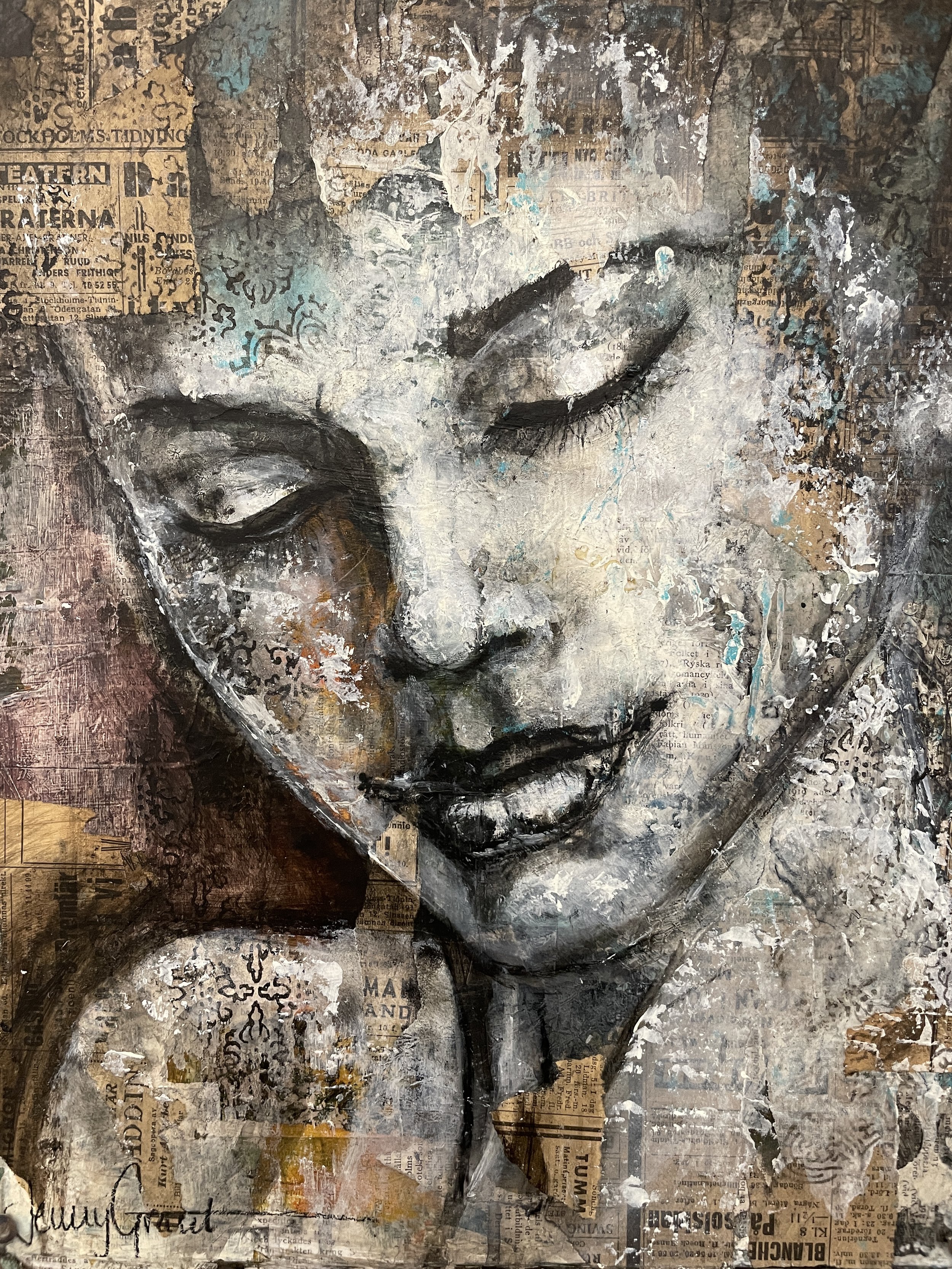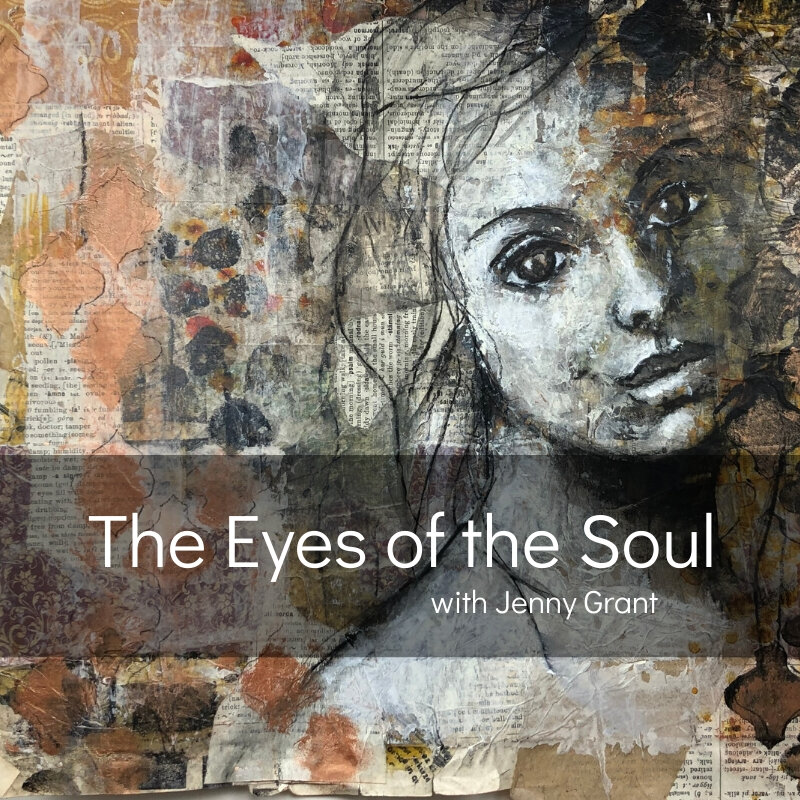Painting faces – and having fun when you do it
I absolutely love painting faces and especially eyes. Faces are one of the most relatable subjects, I think, and the human face holds an incredible power to stir emotions within both me as the artist and those who view my art. It's as if the canvas becomes a window into my soul or the viewers soul, a portal to feelings.
A big part of the process when painting faces, involves connecting with the image on a deep level… to feel the subject. It's almost like having a conversation with the painting itself. A bit woo-woo, but it is actually what I really feel. I often see the eyes in the background, but I do not actually finish the eyes until very late in the process. I find them, loosely mark them and use them to undertand what the painting wants to be. The eyes are the mirror to the soul and for my paintings that is very true. They help me catch the emotions, the personality, and the essence of the painting.
There's something very captivating with this connection, and it's this very connection that makes me looove to paint faces. It's like unlocking a world of emotions and experiences, and when I succeed in capturing those emotions, it's incredibly rewarding. The painting comes to life, and the viewers will most often also feel the energy and be drawn into this emotional journey.
Painting faces is not about creating correct proportions and symmetry, it is not about skin tone or light and shadows; it's about breathing life and soul into the paint. And the magic is when the face is evoking strong emotional responses from me as the artist and to my viewers.
But this is also the reason why painting faces is hard! I would say it is harder than painting any other subject. The reason is that we, as humans, are hard wired to read a face, and to interpret it, and that interpretation evokes feelings. We get really affected by other human faces. There is a connection and feeling as soon as we see a face. Our brain starts to process the face in front of us and that connects how we feel about that face, we read in our own emotions, and we feel for the person deep within us. It is a natural, a primitive response where we make an assessment on the safety of ourselves and our family.
When I paint faces, my desire is mostly to evoke a feeling of calm and harmony. I want to feel good about the face that is looking back from the canvas. Likewise, if you are wanting to reflect the pain a person is going through, you need to capture that.
When you understand the emotional response faces can have, it is little wonder we can get overwhelmed when it comes to painting them.
I used to be so super critical of myself whenever I attempted to paint faces. I spent a while researching the “rules” of painting faces, to perfect the details and the composition but I quickly realised that I just got dissapointed. It just isn’t how I paint, so nothing would work. The soul was not reflected, and my artwork looked flat.
Don’t get me wrong, I took some of the “rules” that made sense to create balance or that resonated with me, and I put my own spin on them to create some looser guidelines (I have never really been one for rules when it comes to creativity).
The good news is, when you master the simplicity of facial features, everything becomes much easier. Yes – I just used the word simple and easy related to painting faces!
How do you paint faces?
A great way to start a face, particularly if you are new to painting faces, is to start with super simple shapes and lines. Starting in this way really allows the face to appear in harmony with the texture of the collage background. The video below guides you through a simple process to get you started. It is important to just use this as a guide. You need to add soul to your faces by listening to the whispers of your heart and feeling your way through your work. Let go of perfectionism and trust your intuition.
Step 1
Start your face by holding your pencil very loosely and sketch out an oval/egg shape. Keep it light and loose.
Step 2
The eyes are roughly in the middle of the face so draw a very light horizontal line to divide the face in half.
As you sketch the eyes I like to work on a simple formula to help me ensure the proportions look right. The space across the face should hold 4 eyes. This is not an exact science but there to guide you that the size of the eyes are approximately ¼ of the size of the face and the eyes are approximately one eye size appart.
Step 3
Halfway between the eyes and the chin will be the tip of the nose.
Step 4
Halfway between the tip of the nose and the chin will be the centre of the mouth. Use this as a mark and create the top and bottom lip around this.
Adding soul to your painting
The fact is, we strive for perfection in our art, but it is our imperfections that make us truly beautiful, unique and reflect our soul.
Whether you start your portraits using the method I use, or you start with a template or tracing from a magazine, it is important to remember this is just the start. As you progress you will add to it and undoubtedly take things away too. This is an important part of the process as it helps you to uncover the soul of your art. Give yourself permission to feel your way as you paint rather than comparing your piece to your reference picture. Your reference picture is just one guide, to help you when it comes to the mechanics of highlights and shadows. Bringing your faces to life lies within you.
Painting faces with Jenny Grant…
If you love my tactile (and often messy) process when it comes to painting faces I would love for you to join me in one of my in-person workshops, in an online class or in Café Flow – The Art Club, a wonderful art community where I share monthly art projects and some fabulous resources to help you top up your creative bucket.
…or with Jenny in collaboration with other artists…
If you are looking for more inspiration and want to explore a range of techniques and styles with some incredible portrait artists (including me) I am excited to share an awesome collaboration that I will be part of in 2025.
Join Let’s Face It 2025
LET’S FACE IT is a course created and hosted by Kara Bullock. It is for anyone that wants to practice creating portraits and figurative art. Each week in 2025, you will receive one new lesson from one of our fabulous artists! These lessons are created to inspire you and expose you to different ways of drawing/painting the face and figure. We all know that there is not a one size fits all way to learn. Together, we want to share with you our strategies, tips, and techniques that we use in order to create our portrait and figurative artwork hoping you will find something that works for you to help you continue on your journey of creating portraits. Not only will you leave this course feeling more confident in your skills, but also with a whole new community of art friends that will keep supporting you from here on out!
To learn more click here .






